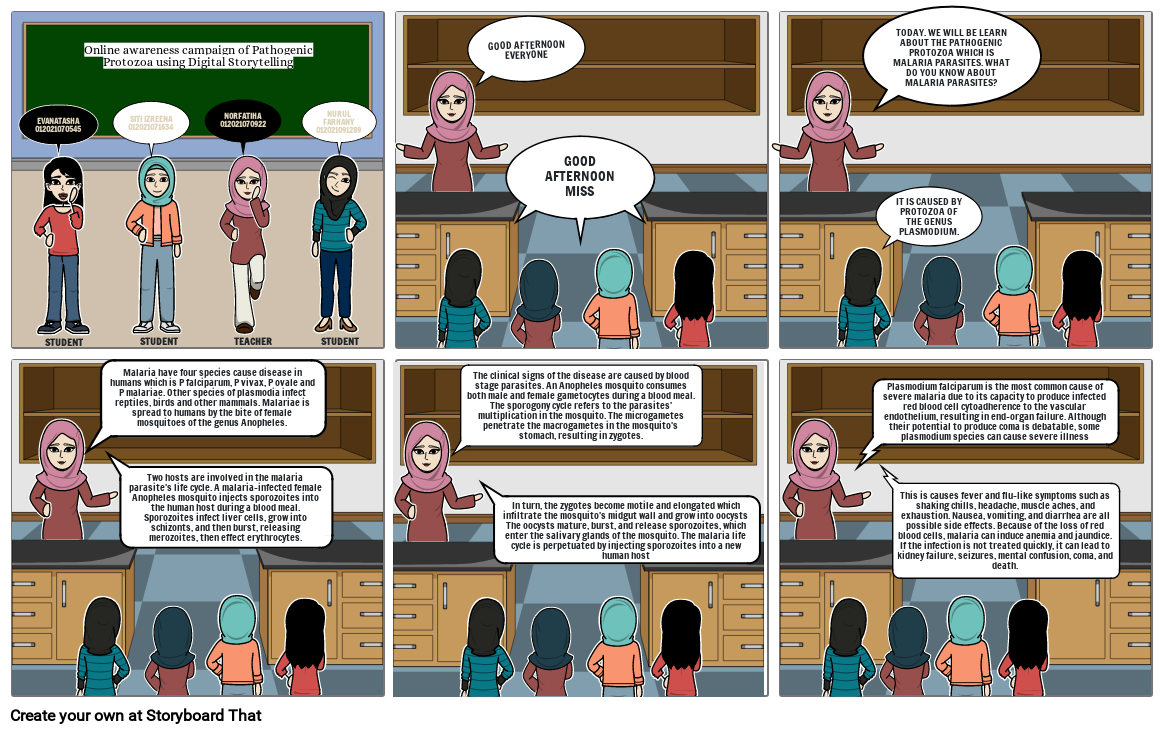MP Microbiology

Storyboard Text
- EVANATASHA012021070545
- STUDENT
- Online awareness campaign of Pathogenic Protozoa using Digital Storytelling
- SITI IZREENA012021071634
- STUDENT
- NORFATIHA012021070922
- TEACHER
- STUDENT
- NURUL FARHANY012021091289
- GOOD AFTERNOON EVERYONE
- GOOD AFTERNOON MISS
- TODAY. WE WILL BE LEARN ABOUT THE PATHOGENIC PROTOZOA WHICH IS MALARIA PARASITES. WHAT DO YOU KNOW ABOUT MALARIA PARASITES?
- IT IS CAUSED BY PROTOZOA OF THE GENUS PLASMODIUM.
- Malaria have four species cause disease in humans which is P falciparum, P vivax, P ovale and P malariae. Other species of plasmodia infect reptiles, birds and other mammals. Malariae is spread to humans by the bite of female mosquitoes of the genus Anopheles.
- Two hosts are involved in the malaria parasite's life cycle. A malaria-infected female Anopheles mosquito injects sporozoites into the human host during a blood meal. Sporozoites infect liver cells, grow into schizonts, and then burst, releasing merozoites, then effect erythrocytes.
- The clinical signs of the disease are caused by blood stage parasites. An Anopheles mosquito consumes both male and female gametocytes during a blood meal. The sporogony cycle refers to the parasites' multiplication in the mosquito. The microgametes penetrate the macrogametes in the mosquito's stomach, resulting in zygotes.
- In turn, the zygotes become motile and elongated which infiltrate the mosquito's midgut wall and grow into oocysts The oocysts mature, burst, and release sporozoites, which enter the salivary glands of the mosquito. The malaria life cycle is perpetuated by injecting sporozoites into a new human host
- Plasmodium falciparum is the most common cause of severe malaria due to its capacity to produce infected red blood cell cytoadherence to the vascular endothelium, resulting in end-organ failure. Although their potential to produce coma is debatable, some plasmodium species can cause severe illness
- This is causes fever and flu-like symptoms such as shaking chills, headache, muscle aches, and exhaustion. Nausea, vomiting, and diarrhea are all possible side effects. Because of the loss of red blood cells, malaria can induce anemia and jaundice. If the infection is not treated quickly, it can lead to kidney failure, seizures, mental confusion, coma, and death.
Over 30 Million Storyboards Created

